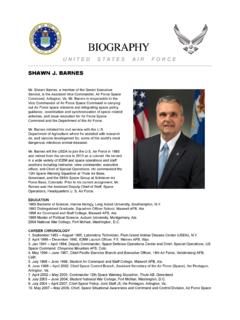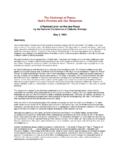Transcription of Disciple-LTA: Learning, Tutoring and Analytic …
1 Journal of Intelligence Community Research and Development, July 2008. Disclaimer: The views and opinions expressed in this article are those of the authors and do not necessarily reflect the official policy or position of any agency of the government. Examples of analysis performed within this article are only examples. They should not be utilized in real-world Analytic products as they are based only on very limited and dated open source information. Assumptions made within the analysis are not reflective of the position of any government entity. Disciple-LTA: learning , Tutoring and Analytic Assistance1 Abstract: This paper presents an overview of Disciple-LTA, a new type of Analytic tool that synergistically integrates three complex capabilities.
2 It can rapidly learn the Analytic expertise which currently takes years to establish, is lost when analysts separate from service, and is costly to replace. It can tutor new intelligence analysts how to systematically analyze complex hypotheses. Finally, it can assist the analysts to analyze complex hypotheses, collaborate, and share information. Keywords: structured argumentation, assumptions-based analysis, learning Analytic expertise, Tutoring new analysts, mixed-initiative Analytic assistance, terrorism. 1. Introduction Disciple-LTA is a unique and complex Analytic tool that integrates powerful capabilities for Analytic assistance, learning and Tutoring . At the basis of Disciple-LTA is an approach to software agent development where a subject matter expert, such as an intelligence analyst, can teach a Disciple software agent how to solve problems in a way that resembles how the expert would teach a student or a new analyst when solving problems in collaboration (Tecuci, 1998).
3 The expert analyst will formulate a specific problem, such as Assess whether Iran is pursuing nuclear power for peaceful purposes , and will explain the agent how she or he performs this analysis. From this specific analysis Disciple-LTA will learn general analysis rules that will allow it to solve similar problems, such as Assess whether Venezuela is pursuing nuclear power for peaceful purposes. As Disciple-LTA learns from the expert analyst, it becomes an increasingly useful collaborator, solving the problems formulated by the analyst similarly to how the analyst would solve them himself or herself, only much faster. This allows the human analyst to act as the orchestrator of the Analytic process, guiding the high level exploration of the reasoning space, while Disciple-LTA implements this guidance, together forming a very powerful team.
4 Critical to the success of Disciple-LTA as an Analytic tool is the use of a systematic approach to hypothesis analysis which is both natural for a human analyst and appropriate for an automatic software agent. This approach facilitates the teaching of a Disciple-LTA agent by an expert analyst. It also allows a trained Disciple-LTA agent to act as a natural extension of the analytical reasoning capabilities of a human analyst, as well as teach new analysts in a way that is similar to how it was taught. This paper presents a very brief overview of Disciple-LTA s capabilities, from a user s point of view. The next section introduces Disciple-LTA s approach to hypothesis analysis. Then section 3 shows how Disciple-LTA helps an analyst to rapidly analyze complex hypotheses and perform assumptions-based analysis.
5 Section 4 illustrates the teaching of Disciple-LTA by an expert analyst, and section 5 discusses how Disciple-LTA can teach new analysts. Finally, section 6 presents an overview of other capabilities of Disciple-LTA. 1 Authors: , M. Boicu, D. Marcu, V. Le, C. Boicu, George Mason University, Fairfax, VA, 22030, email: 2 2. Hypothesis analysis through problem reduction and solution synthesis Disciple-LTA is a knowledge-based software agent that can analyze complex hypotheses through a divide and conquer approach. For instance, let us consider that Disciple-LTA is given the complex hypothesis analysis problem from the top of Figure 1: Assess whether Al Qaeda has nuclear weapons. Disciple-LTA successively reduces this problem to simpler and simpler hypothesis analysis problems, guided by questions and answers: What factors should I consider to determine whether Al Qaeda has nuclear weapons?
6 Characteristics associated with possession of nuclear weapons and current evidence that is has nuclear weapons. Therefore I have to Assess whether Al Qaeda has nuclear weapons based on the characteristics associated with the possession of nuclear weapons. Assess whether there is current evidence that Al Qaeda has nuclear weapons. Each of these two hypothesis analysis problems is reduced in a similar way, guided by questions and answers, as illustrated in Figure 1. This problem reduction process continues until the resulting problems are simple enough to find their solutions. Figure 1: Hypothesis analysis through problem reduction and solution synthesis. 3 Let us consider the leaves of the tree from Figure 1. One of them represents the simpler hypothesis analysis problem: Assess whether Al Qaeda considers the use of nuclear weapons in spectacular operations as a reason to obtain nuclear weapons.
7 The solution of this problem appears in a green background: It is almost certain that Al Qaeda considers the use of nuclear weapons in spectacular operations as a reason to obtain nuclear weapons. This and the other solutions of the problems from the bottom of Figure 1 are successively combined, from bottom-up, to synthesize the solutions of the upper-level problems, until the solution of the top level problem is obtained: It is likely that Al Qaeda has nuclear weapons. Disciple-LTA uses five symbolic probabilities (such as likely or almost certain) to express the solutions of the problems. They correspond to the National Intelligence Council s standard estimative language. However, this could easily be changed to consider more or fewer symbolic probabilities and to associate specific probability intervals with each of them (Kent 1994; Heuer, 1999).
8 Notice also that some words appear in blue. They correspond to entities (such as Al Qaeda or nuclear weapons) that are represented in the knowledge base of Disciple-LTA (Tecuci et al, 2007). Figure 1 shows only the top part of the problem reduction and solution synthesis tree. The problems from the bottom of Figure 1 are themselves reduced to simpler problems in order to solve them. Overall, the entire reasoning tree has over 1,700 nodes. To help browse and understand such a complex analysis, Disciple-LTA displays a simplified version of it, as illustrated in the left-hand side of Figure 2. Figure 2: Evidence and source analysis. Detailed evidence and source analysisEVD-FP-Glazov01-01c 4 Under the initial problem and its solution (Assess whether Al Qaeda has nuclear weapons: likely) Disciple-LTA lists the short names of the bottom problems from Figure 1 and their solutions: Deterrence as reason: an even chance Self defense as reason: an even chance Spectacular operations as reasons: almost certain.
9 Each of these simpler problems is solved by using the same reduction and synthesis approach. Let us consider Spectacular operation as reason which is a short name for Assess whether Al Qaeda considers the use of nuclear weapons in spectacular operations as a reason to obtain nuclear weapons. As indicated in the left-hand side of Figure 2, to solve this hypothesis analysis problem Disciple-LTA considered both favoring evidence and disfavoring evidence. Disciple-LTA has found two pieces of favoring evidence, EVD-FP-Glazov01-01c and EVD-WP-Allison01-01, and it has analyzed to what extend each of them favors the hypothesis that Al Qaeda considers the use of nuclear weapons in spectacular operations as a reason to obtain nuclear weapons. EVD-FP-Glazov01-01c is shown in the bottom right of Figure 2.
10 It is a fragment from a magazine article published in the Front Page Magazine by Glazov J. where he cites Treverton G. who stated that Al Qaeda may perform a spectacular nuclear attack against United States (Glazov, 2003). To analyze EVD-FP-Glazov01-01c, Disciple-LTA considered both its relevance and its believability (Schum, 2001; 2007). The believability of EVD-FP-Glazov01-01c depends both on the believability of Glazov J. (the reporter of this piece of information) and the believability of Treverton G. (the source). The believability of the source depends on his competence and his credibility. The credibility of Treverton G. depends on his veracity, objectivity, and analytical ability. When the user of Disciple-LTA clicks on a problem, such as Credibility from the left-hand side of Figure 2, Disciple-LTA displays the details on how it solved that problem, as shown in the right-hand side of Figure 2.






